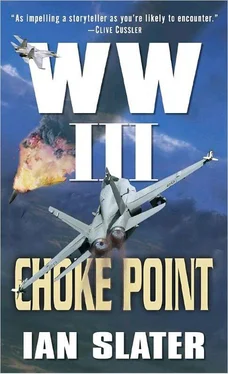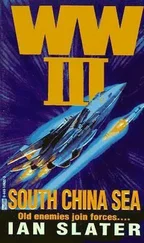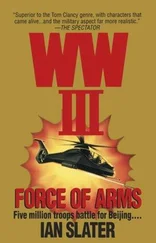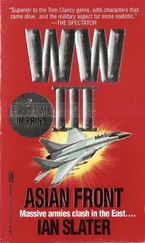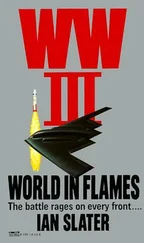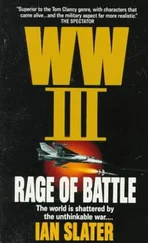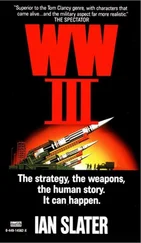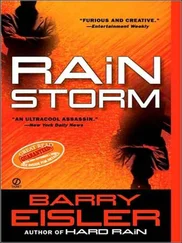“They can swim,” said Freeman tersely. “ ’Sides, they can pull their rip cords if they have to.” He meant that Aussie and Dixon could activate their Mae West inflatables.
Choir nudged the islet’s side with the RIB and, despite the foamy, choppy water, could see a protruding ledge three feet below. If there was a sudden suck-down, the RIB’s fiberglass keel could find itself on the ledge and tip.
“Piece o’ cake,” Sal told him, Salvini sensing Choir was worried about what could be a tricky docking in the chop.
“You ready with that line?” Choir asked Sal.
“Good to go, Mr. Williams.”
“When I say go — right?”
“Right.”
The ROC F-16 was escorted by two of McCain ’s F-18 Super Hornets, one of which was piloted by Chipper Armstrong and his RIO Evans, the other by Manowski and his RIO. Evans was still smarting from having been left out the dogfight against the ChiComs, and Manowski’s RIO was in no better mood as the pair of Super Hornets continued to escort the “Bizarro” Taiwanese Falcon toward the carrier battle group.
Admiral Crowley, though still in shock over his squadrons’ failure to prevent the bombing of Penghu, nevertheless had to force himself to concentrate on the Bizarro situation. His position about not allowing the Falcon to land still stood. For one thing, the Taiwanese Falcon, not being a carrier aircraft, did not have sufficient underbelly strength to make a hard carrier landing; hence the nickname “Jelly Dick,” by which “Hard Dick” Navy aviators condescendingly referred to Air Force fighters. An F-16 pilot, at his best, trying to minimize the shock of hitting the carrier deck, would probably collapse his landing gear, the fighter skidding and cartwheeling and either crashing into billions of dollars of McCain ’s parked aircraft or slamming into the base of the island. In either case, there would be massive fire wreckage, which would mean Crowley couldn’t bring in his low-on-gas squadrons coming back from Penghu. It was a nightmare scenario. The rescue of one pilot, Taiwanese or American, wasn’t worth the risk to the McCain and those who worked on her.
“We could put out a net,” Cuso suggested, but Crowley shook his head; the idea of using “Badminton”—a big net stretched across the deck — to break the touchdown of a plane so low on gas that it didn’t have enough fuel left for a “go-around,” or was in some other way incapacitated, still ran the risk of the Falcon crashing into McCain ’s superstructure — the carrier’s island — before it reached the net.
“No,” said Crowley with an air of finality. “He’ll have to ditch. Have our chopper pick him up.”
Cuso nodded assent, but felt compelled, no doubt because he’d been an aviator himself, to add, “Chipper says the pilot’s shot up pretty bad. Ejection might not be an option.”
“Life’s tough!” Crowley said brusquely. “If he can’t eject, maybe he can ditch — stay afloat long enough for our helo to snatch him.”
Cuso said nothing. They both knew that if the pilot was so badly wounded that he couldn’t reach down to grab the snake — the F-16’s ejection pull loop — then he almost certainly didn’t have the strength required to boss the controls to pancake long enough for the Jolly Green Giant helicopter reach him.
Crowley conveyed his decision to the rescue helo, Chipper Armstrong, and Manowski.
“Thrilling mission, Chip,” came the wry voice from his backseat.
“Well, look at it this way, Eagle,” said Chipper. “Maybe Bizarro is the son of one of those super-rich Taiwanese industrialists, and when he gets home, Daddy’s gonna be so grateful, you and I get a big, fat envelope — reward for fishing Junior out of the chuck.”
“Your oxygen feed must have dropped below twenty, right?”
“Maybe,” Chipper answered, his voice tired but, not surprisingly, no longer as tense as when FITCOMPRON took off. The sight of the carrier, and the focus needed for landing on a “postage stamp,” was always a pick-me-up. The only problem remaining, given that the Taiwanese fighter’s radio was out, was that either Armstrong or Manowski would have to make it clear to Bizarro that he or she wouldn’t be allowed to land on the carrier and would have to eject or ditch. Eagle Evans, however, already had the potential problem solved. Using his navigation highlighter, on the inside of his cockpit he’d drawn a rough, simple diagram of an L-shaped pilot’s seat inclined backward, showing an arrow curving up and out from it, his large drawing clearly visible to the pilot of the shot-up Falcon.
“Outstanding, Eagle,” said Manowski on the far right side of the Falcon. “I can make that out from here. If Bizarro can’t see that, man, he’s blind.”
Chipper brought the Hornet in closer to the Falcon, his thumb gesticulating to Evans’s ad hoc poster, which Chipper now knew would pass into the folklore of the “boat,” along with the sadness of having lost so many good aviators in the miscalculation of the ChiComs’ intentions over Penghu.
“He sees it,” Manowski said, the wingman glimpsing the Falcon’s driver, who, though grimacing in pain, slowly raised his hand from the control stick and pointed a bloodied thumb. “He’s gonna do it,” Chipper advised McCain ’s CIC. “He’s gonna eject.”
“Roger that,” came CIC’s recognition. “Put yourselves between him and the boat, just to be sure. Repeat — you and Manowski get between him and the boat.”
McCain ’s two Super Hornets did so, Chipper speeding a quarter mile ahead, Manowski neatly executing a sideslip left, over the Falcon and into what had been Chipper’s position. Both Hornets were in a shallow low left turn at three thousand feet toward the McCain , leveling out two miles from the carrier. The three planes, now down to 200 knots, had been given clearance to pass through the carrier battle group’s usual no-fly zone. McCain ’s Jolly Green Giant was already aloft, its swimmers checking their gear as the chopper’s pilot, McCain ’s CIC, Armstrong, and Manowski verified that everyone was on the same page vis-à-vis the precise GPS spot near which they’d like the pilot to ditch.
“Can Leonardo draw another billboard?” inquired John Cuso, with an unmistakable tone of admiration for RIO Evans’s initiative.
“Can do,” confirmed Eagle, quickly slipping pages out of his knee pad to write out the GPS numbers. The three jets were aft of McCain , beginning a slow, wide U-turn left, the Falcon pilot obediently pulling to the outside so the two Super Hornets were again between it and the carrier, now a mile to the west. Suddenly, the Falcon pilot began pointing down at his digital control panel with such urgency that the four Americans could see he was plainly alarmed.
“He’s out of gas,” proffered Manowski’s RIO, “and too low for him to eject. Damn!”
“I don’t—” began Manowski. Then they saw the pilot’s thumb jabbing down again, this time toward the sea.
“Give him room!” ordered Cuso, who then advised the helo, “Go get him, but keep clear of debris till he’s settled. Chipper, Manowski, stand by to enter glide path.”
The Falcon was trying to go into as shallow a dive as possible toward the sea, but Chipper and Manowski could see there’d be no pancake landing, but a pelican crash — a nosedive that would drive the Falcon into the ocean with such impact, there would be little chance of rescue.
“God, he almost made it,” cut in Evans. “Only a mile out and—”
At a thousand feet the Falcon made an astonishing recovery, the pilot managing to pull it out of the dive. Chipper’s HUD showed it leveling off at three hundred feet at 400 knots. It was Eagle-eyed Evans who, despite the obtuse angle of the Hornets’ aviators to the Falcon, spotted the twin red dime-sized glows, the Falcon going to afterburner, its blip on both Hornets’ radar moving rapidly from 400 knots to 950, breaking hard right, hard left, hard right, from the beginning of what was expected to be its crash landing on the McCain but in fact was a crash dive.
Читать дальше
